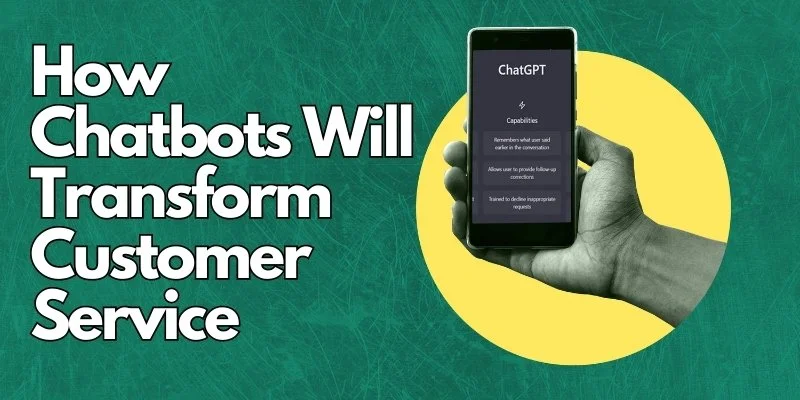
Customer service is an underrated but crucial aspect of any business, as it directly impacts customer satisfaction and loyalty.
With the advancements in technology, chat support has emerged as a powerful tool for enhancing customer experiences.
In recent years, chatbots, powered by artificial intelligence (AI), have gained significant popularity in the customer service industry.
In this blog, we will explore how chatbots will transform customer service and chat support.
What are Chatbots
Chat support refers to the use of chat-based communication platforms to interact with customers and provide assistance.
Chatbots, on the other hand, are computer programs designed to simulate human conversation and automate interactions with users.
There are two main types of chatbots: rule-based and AI-powered.
Rule-Based Chatbots: Rule-based chatbots follow pre-defined rules and responses programmed by humans.
They are suitable for handling simple and straightforward customer queries.
These chatbots operate based on a set of predetermined rules and cannot learn or adapt beyond their programmed responses.
AI-Powered Chatbots: AI-powered chatbots leverage natural language processing (NLP) and machine learning algorithms to understand and respond to user queries.
These chatbots learn from customer interactions, improve their responses over time, and provide more personalized and accurate support.
They can handle complex inquiries and are capable of adapting to new scenarios.
Advantages of Chat Support
24/7 Availability
One of the significant advantages of chat support and chatbots is their round-the-clock availability.
Unlike traditional customer support methods, chatbots can handle customer inquiries and provide assistance at any time of the day.
According to a survey conducted by Statista, 64% of consumers expect companies to offer 24/7 customer support.
Chatbots fulfill this expectation by providing instant responses and support, irrespective of the time of day.
Instant Responses
Customers today expect quick and efficient resolutions to their queries.
With chat support and AI-powered chatbots, businesses can provide instant responses to customer inquiries.
Research by HubSpot reveals that 90% of consumers rate an immediate response as important or very important when they have a customer service question.
Chatbots can analyze customer queries in real time and provide relevant answers promptly, reducing the waiting period and increasing customer satisfaction.
Scalability
As businesses grow, managing increasing customer inquiries can become challenging.
Chatbots excel in scalability, as they can handle multiple conversations simultaneously. This scalability eliminates the need to hire additional customer support agents to handle the growing demand.
A study by Juniper Research estimates that chatbots will help businesses save over $8 billion annually by 2022 through reduced customer support costs and increased efficiency.
Cost-Effectiveness
Implementing chat support with chatbots can significantly reduce customer service costs.
According to IBM, businesses can save up to 30% on customer support costs by utilizing chatbots.
Chatbots require minimal infrastructure and can handle a large volume of inquiries without the need for additional human resources.
This cost-effectiveness makes chat support an attractive option for businesses of all sizes.
Personalization
Customers appreciate personalized experiences that cater to their individual needs.
Chatbots can be programmed to gather customer data and preferences, enabling them to provide personalized recommendations and solutions.
A study by Accenture found that 91% of consumers are more likely to shop with brands that recognize, remember, and provide relevant offers and recommendations.
By leveraging customer data, chatbots can create personalized interactions that enhance customer engagement and satisfaction.
50 Must-Know Chatbot Statistics in 2023
How Chatbots Will Transform Customer Service
Enhanced Customer Experience
Chatbots contribute to an enhanced customer experience by providing quick, accurate, and personalized responses.
They eliminate the need for customers to wait in queues or navigate through complex phone menus.
According to a report by Forbes, 84% of consumers believe that the experience a company provides is as important as its products and services.
By offering seamless and efficient support, chatbots play a pivotal role in delivering positive customer experiences.
Efficient Issue Resolution
Chatbots are adept at resolving common customer issues promptly.
They can access knowledge bases, FAQs, and product information in real time, providing customers with accurate and relevant solutions.
Research by Kayako reveals that 79% of customers prefer live chat support due to its immediate response capabilities.
By quickly addressing customer queries and issues, chatbots contribute to higher customer satisfaction and retention rates.
Proactive Customer Engagement
Chatbots have the ability to initiate conversations and engage with customers proactively.
They can send personalized messages, notifications, and recommendations based on customer behavior and preferences.
This proactive engagement helps businesses to nurture customer relationships and drive sales.
According to a study by Facebook, 53% of people are more likely to shop with businesses they can message directly.
Chatbots enable this direct messaging, enabling businesses to connect with customers in a personalized and timely manner.
Data Collection and Analysis
Chatbots provide a valuable source of customer data for businesses.
They can gather information such as customer preferences, purchase history, and frequently asked questions.
This data can be analyzed to gain insights into customer behavior, preferences, and pain points.
According to a survey by Salesforce, 79% of customers expect personalized experiences from the brands they engage with.
By leveraging the data collected through chatbots, businesses can deliver tailored experiences that meet customer expectations.
Integration with Other Channels
Chatbots can seamlessly integrate with other customer service channels, such as email, social media, and phone support.
They can assist customers across multiple platforms, ensuring a consistent and unified experience.
Research by Twilio found that 85% of consumers want to be able to switch seamlessly between channels when interacting with a business.
Chatbots facilitate this omnichannel support, enabling customers to engage with businesses on their preferred platforms.
The Great Chatbot Debate: Do Consumers Really Want Them?
Potential Challenges and Limitations
Complex Situations or Sensitive Interactions
Chatbots may struggle to handle complex queries or situations that require human empathy and understanding.
Customers with unique or intricate problems may not receive the level of support they require solely from chatbots.
In such cases, a seamless handoff to a human agent is necessary to provide a more personalized and empathetic resolution.
Seamless Transition to Human Agents
To ensure a smooth customer experience, it is crucial to establish an effective handoff process from chatbots to human agents when needed.
This transition should be seamless, with all relevant customer information and chat history transferred to the human agent.
Training and coordination between chatbots and human agents are key to providing a consistent and high-quality customer experience.
Ongoing Monitoring and Training
Chatbots require ongoing monitoring and training to improve their performance.
This includes regularly analyzing chat logs, identifying areas where chatbots may struggle or provide inaccurate responses, and updating their knowledge base accordingly.
Continuous improvement ensures that chatbots remain effective and reliable tools for customer support.
Best Practices for Implementing Chat Support
Setting Clear Goals and Objectives
Clearly define the goals and objectives of implementing chat support, such as improving response times or reducing customer support costs.
This will guide the implementation process and help measure the success of chatbot integration.
Choosing the Right Chatbot Platform or Solution
Select a chatbot platform or solution that aligns with your business requirements.
Consider factors such as integration capabilities, scalability, and customization options.
Designing Conversational User Interfaces (CUIs)
Design intuitive and user-friendly conversational interfaces for chatbots.
Focus on creating a natural and engaging conversation flow that provides a seamless user experience.
Training Chatbots and Continuous Improvement
Regularly train and update chatbots to improve their understanding of customer queries and responses.
Continuously monitor and analyze chatbot performance to identify areas for improvement.
Providing Seamless Handoff between Chatbots and Human Agents
Implement a smooth handoff process from chatbots to human agents when complex or sensitive issues arise.
Ensure that human agents are well-equipped to take over and provide personalized support.
Collaboration between chatbots and human agents is crucial to maintaining a high level of customer service and ensuring customer satisfaction.
Conclusion – How Chatbots Will Transform Customer Service
Chat support, powered by chatbots, is revolutionizing the customer service industry.
The advantages of 24/7 availability, instant responses, scalability, cost-effectiveness, and personalization make chatbots a valuable tool for businesses.
By enhancing customer experiences, efficiently resolving issues, engaging proactively, collecting data, and integrating with other channels, chatbots are transforming the way businesses interact with their customers.
Embracing chat support and leveraging chatbots can lead to improved customer satisfaction, increased efficiency, and ultimately, business growth in today’s digital era.
FAQs
-
What is an example of a customer service chatbot?
GPT-3 by OpenAI serves as a sophisticated example of a customer service chatbot.
It is designed to comprehend and respond to customer queries in real time, leveraging its expansive language model to mimic human-like interactions and provide relevant solutions.
-
What are the benefits of chatbots in customer service?
The benefits of chatbots in customer service include 24/7 availability, instant responses, enhanced customer satisfaction, cost-effectiveness, scalability, and personalized interactions, based on customer data.
-
How do chatbots change customer service?
Chatbots are transforming customer service in several key ways. They are capable of providing immediate, personalized responses.
Additionally, the data collected by chatbots can be used for analytical purposes, thereby allowing businesses to better understand customer needs and improve their services.
-
What is the role of chatbots in customer service and marketing?
Chatbots play dual roles in both customer service and marketing.
In customer service, chatbots provide instantaneous, round-the-clock support, swiftly addressing issues and enhancing the overall CX.
From a marketing point of view, chatbots help collect valuable customer data, provide personalized recommendations based on individual preferences, and enable proactive customer engagement.

![What is Shrinkage in the Call Center [Updated 2025]](https://www.hiredsupport.com/wp-content/uploads/2025/04/What-is-Shrinkage-in-Call-Center-1-300x169.png)
